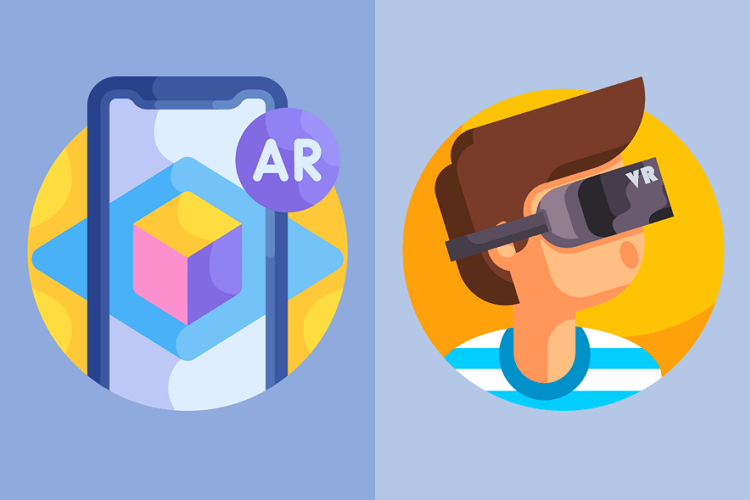The COVID-19 pandemic has caused a dramatic shift in the way students learn, with millions now learning remotely. This shift has provided a further boost to educational technology (ed-tech) and online education, emphasizing the importance of teaching tools such as augmented reality (AR) and virtual reality (VR). The move to online and hybrid learning has highlighted the need for these tools, which are proving to be essential in providing students with an engaging and interactive learning experience.
Integrating Augmented Reality (AR) and Virtual Reality (VR) technologies into the classroom has enabled teachers and students to visualize the set standards more effectively. This has made it easier and more feasible for them to adapt to the latest technologies. In simpler terms, AR/VR is the rising phoenix of the EdTech industry.
AR and VR have revolutionized how teachers and students interact with each other and the material being taught. By utilizing AR and VR, teachers can create more engaging and interactive learning experiences for their students while students can better understand the material being taught. Furthermore, these technologies provide a platform for students to explore and experiment with concepts in a more immersive and realistic environment.
This article will help you understand how AR/VR revolutionizes the education industry. The AR/VR app market was valued at $1.83 billion in 2020 and is expected to witness a CAGR of 38.29% through 2027. Thus, it is now the right time to hire a dedicated education app development company to help you traverse this growing economy while paving the way for the success of your business.
How AR/VR is Revolutionizing the Education Industry?

1. Making learning enjoyable
AR/VR is capable of making learning rather fun and accessible, thereby making way for improved cooperation as well as capacities. In addition, the AR/VR has the potential to make the lessons more enjoyable by allowing students to use hands-on learning techniques that ensure increased engagement and better learning experience while allowing them to practice new skills at hand.
2. Encouraging Self Learning
The AR/VR integrated headgear can reduce the overall distraction by the external stimulus, allowing the learners to focus hard on virtual learning activities. For instance, students can use their smartphones and the education apps integrated with AR/VR to make way for a modernized and seamless learning experience rather than buying an expensive headset just for the sake of it. The EdTech apps can offer the students a live view of the digital elements that can be simply seen with the help of smart glasses or even smartphones.
3. Easy visualization of complex topics, locations, and more
Comprehending complex and intricate concepts, such as molecular structures in chemistry, anatomical notions in biology, space phenomena, or abstract themes, can be challenging to explain or visualize in a classroom setting. Children often struggle to comprehend and retain an understanding of these topics. However, using 3D and augmented reality (AR) in e-learning can make these concepts much more straightforward.
This is because learners can gain a vivid and dynamic experience that merges the physical and virtual worlds. Through augmented reality (AR) and virtual reality (VR), knowledge can be conveyed through vivid, realistic 3D models, thereby effectively communicating concepts or abilities.
4. Allowing the learners to practice complex concepts in real-time
The traditional educational system tends to focus more on theory than practice, leading to students forgetting the concepts they learn in class. Augmented Reality (AR) and Virtual Reality (VR) applications can help to combat this issue by providing students with a more interactive and engaging learning experience.
Through these applications, students can interact with content and practice in real time, which improves understanding, promotes knowledge recall, strengthens retention, and increases motivation and involvement. In many cases, one lesson in the virtual world can replace dozens of traditional ones. Furthermore, VR can be used to transport students to remote or no longer existing sites, allowing them to learn more about history and geography.
5. Contributing the K-12 education
Immersive solutions integrated with AR/VR capabilities are becoming increasingly popular among K-12 instructors, all thanks to their unique features and capabilities. AR/VR systems can be used to supplement, partially replace, or completely replace traditional classroom instruction. The most common application of these systems in K-12 settings is to enhance classroom experiences.
For example, teachers can make use of AR to take the students on virtual field trips as well as exhibitions while making way for them to interact with 3D objects. The AR/VR integrated tools can also be used by schools to promote distance learning.
The AR/VR technology has taken the EdTech sector up a notch and is proving to be a major boon for the industry. These technologies are now only offering the students an immersive and entertaining learning experience, but they are also helping in alleviating the issue of offering quality education across millions of students of the world. It is clear that AR and VR are here to stay and will continue to be a major part of the ed-tech sector.
Now that you have understood the importance of AR/VR in the education industry and how it is redefining modern education, it is now time to be future-ready and choose one of the reliable and dedicated education app development companies that can help you offer customized and content-driven solutions and rekindle the student’s interest in learning.


